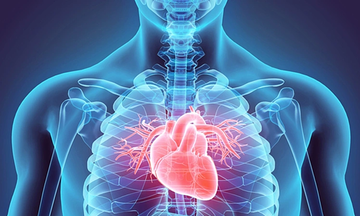When Tung visited Tam Anh General Hospital in Hanoi, he weighed 117 kg, stood 1.8 m tall, and had a BMI of 36.3, classifying him as severely obese. He also experienced loud snoring, difficulty walking, and pain in his knees and ankles. Test results and diagnostic imaging revealed elevated uric acid levels, lipid disorders, fatty liver, and visceral fat measuring 260 cm2 (over 2.5 times the safe threshold).
Doctor Le Ba Ngoc, Head of the General Internal Medicine Department, noted that Tung's skeletal muscle mass was only 37.9 kg, indicating that most of his excess weight was fat. Tung also exhibited symptoms of anxiety and depression, leading him to eat for emotional comfort, further contributing to his weight gain. Doctor Ngoc advised Tung to lose weight to prevent early cardiovascular complications, type 2 diabetes, and joint diseases.
A multi-specialty treatment plan was developed for Tung, involving endocrinology, nutrition, sports medicine, and psychology. Doctor Ngoc emphasized that full adherence to this plan was crucial for successful weight loss. Due to Tung's BMI exceeding 30 and the presence of several dangerous complications, he was prescribed injectable weight-loss medication. This medication works by acting on the brain's hunger control center, reducing cravings, prolonging feelings of fullness, and slowing down the stomach emptying process.
 |
Doctor Ngoc checks Tung's health during his most recent follow-up appointment. Photo: Tam Anh General Hospital |
Doctor Ngoc checks Tung's health during his most recent follow-up appointment. Photo: Tam Anh General Hospital
Tung's nutritional plan was scientifically designed to reduce his caloric intake while ensuring he received all the essential micronutrients for development. The ratio of protein, carbohydrates, and healthy fats was carefully adjusted based on body composition analysis and his eating and lifestyle habits. Tung was also guided on changing the order of his meals, prioritizing fiber intake from fresh fruits and vegetables, and staying hydrated.
"The first week of this program was the most challenging because I had to completely cut out fast food and sugary drinks," Tung said, adding that this change tested his mental endurance, as previously, "eating and drinking was the only way to relieve fatigue and stress".
To help Tung overcome his food addiction, a psychologist employed various therapeutic methods and relaxation techniques to regulate his stress responses and cultivate a positive, sustainable mindset.
With his weight at 117 kg, Tung began with cardio exercises like brisk walking and stationary cycling. As he adapted, a sports medicine specialist gradually increased the intensity, encouraging Tung to divide his workout throughout the day to minimize stress on his musculoskeletal system.
After a month of diligently following the multi-specialty program, Tung adjusted to the new diet and exercise regime. His cravings significantly decreased, his body became more agile, and he lost 10 kg. His visceral fat reduced by 50 cm2, he maintained his muscle mass, and his uric acid levels, lipid profile, and fatty liver condition improved. Tung is continuing his treatment to achieve a healthy weight.
Minh Anh
* The patient's name has been changed
| Readers can submit questions about endocrine diseases here for doctors to answer. |












